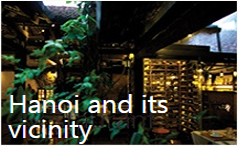Facts and Figure
Hanoi capital of the Socialist Republic of Vietnam is the Political - Cultural - Scientific and Technological center of the whole country. It is also the big centre for economic and international exchange. Through 1000 years of establishment and development, since King Ly Thai To selected Dai La in To Lich river mouth as the capital, Hanoi has witnessed the ups and downs of most of Vietnam feudal dynasties from Ly to Tran-Le-Ma and Nguyen…. Thang Long capital city is seen as the business – Cultural- Education Centre of the North.
Hanoi capital of the Socialist Republic of Vietnam is the Political - Cultural - Scientific and Technological center of the whole country. It is also the big centre for economic and international exchange. Through 1000 years of establishment and development, since King Ly Thai To selected Dai La in To Lich river mouth as the capital, Hanoi has witnessed the ups and downs of most of Vietnam feudal dynasties from Ly to Tran-Le-Ma and Nguyen…. Thang Long capital city is seen as the business – Cultural- Education Centre of the North.
Geographical Co-ordinate:
Hanoi lies between 20053' to 21023' North latitude and 105044' to 106002' East longitude. Hanoi borders Thai Nguyen – Vinh Phuc to the North; Ha Nam – Hoa Binh to the South; Bac Giang – Bac Ninh – Hung Yen to the East and Hoa Binh – Phu Tho to the West.
Natural area:
Following the conclusion of the Party Central Committee's 6th Plenum and the Resolution No.15/2008/NQ-QH12 of the 12th National Assembly, the 3rd Session which has been in effect since May 29th, 2008, after the merging and expansion of the capital administrative border, Hanoi political structure includes: Hanoi city, Ha Tay province, Me Linh district – Vinh Phuc province and 4 communes of Luong Son district – Hoa Binh province. After the expansion, Hanoi covers on an area of 334,470.02 ha which triples its previous size and stands in the list of 17 biggest capitals in the world. The population also increases 1.5 times with 6.2 million by the time of the expansion and 7 million people at current, with 30 administration units at district and town level and 577 communes, wards and towns.
Hanoi now contains hills and mountainous areas with the terrain gradually lower from the North to the South, from the West to the East. The delta area accounts for ¾ of the total natural area of the city. The average height of the terrain ranges from 5 to 20 meters above the sea level. The hills and mountainous zones are located in the Northern and Western part of the city. The highest peak is at Ba Vi with 1,281 m, next is Gia De with 707m; Chan Chim with 462m; Thanh Lanh with 427m and Thien Tru with 378m… Several low hills like Dong Da Moud, Nung mountain are found in the inner city.
Hydrology:
Hanoi is created from the Red River delta which features Hanoi as a "River and Lake city" or "City in River". The continuous flows of big and small rivers in dozens thousand of year has brought alluvium that makes the delta fertile. At present, there are 7 rivers running through Hanoi: Red river, Duong river, Da River, Nhue river, Cau river, Day river and Ca Lo river. Among which, the section of Red river going through Hanoi is163km (taking up 1/3 of the length of the river going through Vietnam). In the inter city, apart from To Lich and Kim Nguu rivers, there is a system of lakes and damps which functions as a drainage system for the city.
In the past century, there are 100 big and small lakes and most of them are natural ones or lakes that are created from the remains of dead rivers or the renovation of swampy fields. Nowadays, most of them have been leveled for construction, however, there still remain hundreds of big and small lakes and damps scattering in different wards and communes of Hanoi. The most famous lakes are Hoan Kiem, West Lake, Quang Ba, Truc Bach, Thien Quang, Bay Mau, Thanh Nhan, Linh Dam, Yen So, Giang Vo, Dong Mo, Suoi Hai..etc.
Those lakes and damps are not only considered as the big water reservoir of Hanoi but also as a natural air conditioner system to help reduce the hot temperature of concretes, steels, bitumen and activities of factories in the urban areas. The lakes and damps in Hanoi not only offer cool climate for the urban area but also beautiful landscapes and special cultural areas of Thang Long – Hanoi.
Climate and Weather:
Located in the tropical moonsoons zone, Hanoi climate is characterised by humid monsoon, hot and rainy summer and cold and dry winter. There are four distinct seasons in a year: Spring, Summer, Autumn and Winter. Springs start from February (or January according to the Lunar Calendar) to April. Summers which run from May to August are hot with plenty of rain. Autumns beginning from August to October are featured with cold weather and the falling of yellow leaves. Winters go from November to January of next year with cold and dry weather. The transition between the four seasons is only relatively. The Winter may come earlier or later than usual or the summer may last for a long time. The temperature may rise up to 40°C in Summer or reduce to below 5°C in Winter.
Hanoi receives an abundant solar radiation. The average amount of radiation in Hanoi is 120 kcal/cm² annually and the average annual temperature is 24.9°C. The average annual humidity is 80 - 82%. The average annual rainfall is 1.800mm (approximately 114 days of rain in a year).
In history, Hanoi has many times experienced the changes in climate and weather. In May, 1926, Hanoi witnessed a terrible hot weather with the temperature coming up to 42.8°C. January 1955 was the coldest winter in history in which the temperature fell to 2.7°C. And recently, in November 2008, after the expansion of Hanoi administrative border, Hanoi experienced the most torrential rain in history. Most of the streets were submerged under water. The rainfall was much larger than prediction which caused the worst flooding in the history of Hanoi, killing people and resulting in remarkable property damages.
Population
After 4 times of adjustments of the administrative border, Hanoi Capital has become one of the largest 17 capitals in the world. In the liberation day in 1954, Hanoi's population was only 53,000 people. In 2004, the number increased to 7.2 million in which 1 million citizens who have not registered for permanent residence has not been included.
In 1954, Hanoi covered an area of 152 km2 with a population of 53,000. In 1961, the city was expanded to 584 km2 with a population of 91,000. In 1978, the National Assembly decided to make the 2nd expansion of Hanoi, increasing the capital's area to 2,136 km2 with a population of 2.5 million. In 1991, Hanoi border continued to be changed which was downsized to 924 km2 with a population of 2 million. In the 1990s, along with the urbanization of Hanoi's suburban areas, Hanoi population increased steadily, reaching 2,675,116 people in 1999.
Hanoi's current population density at current as well as before the expansion was different between inner and suburban districts. In the city, the average density is 2,100 people/km2, but in Dong Da district (previously called Hoan Kiem district), the figure reaches up to 35,341 people / km2. Meanwhile, in outskirts districts like Soc Son, Ba Vi and My Duc, the density is below 1,000 people / km2.
Regarding population structure, according to statistics of 1999, residents in Hanoi and Ha Tay at that time were mostly King people, accounting for 99.1% of the total population. Other ethnic groups such as Dao, Muong and Tay occupied only 0.9%. Results of the population survey conducted on April 1st, 2009 showed that the whole city had 2,632,087 urban residents, equal to 41.2% of the total and 3,816,750 rural people, making up 58.1%.




